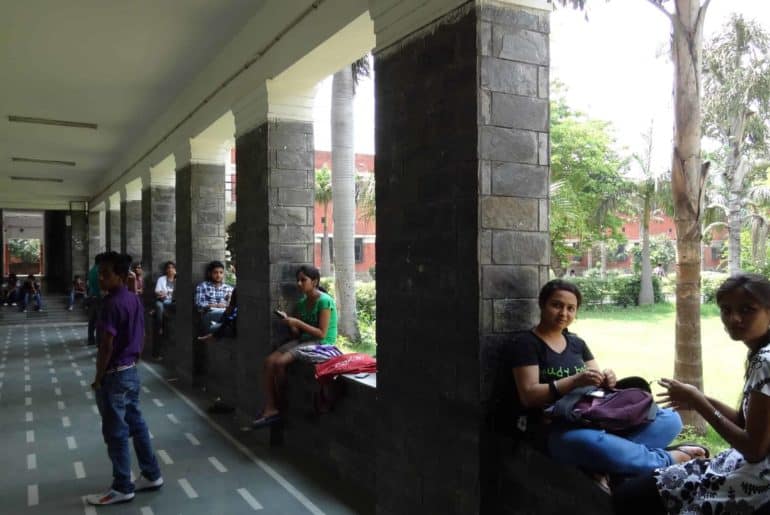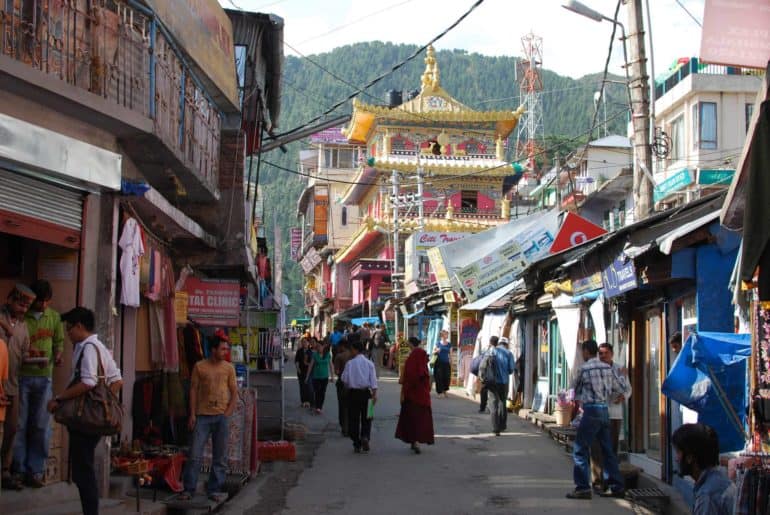 Isn’t Maggi just the ideal snack to gorge on? It’s “finger licking good”, easily available and doesn’t stab too hard on your pocket. For your information, it’s Maggi or simply FYI as it is commonly known as among students, is the latest addition to the scores of popular Maggi points situated in North Campus, Delhi University.
Isn’t Maggi just the ideal snack to gorge on? It’s “finger licking good”, easily available and doesn’t stab too hard on your pocket. For your information, it’s Maggi or simply FYI as it is commonly known as among students, is the latest addition to the scores of popular Maggi points situated in North Campus, Delhi University.
To reach there, take the stairs going to down to a basement, in the lane right opposite the Mc Donald’s take away counter. As you open the door, you find yourself in a lively room with walls painted bright yellow and red, and low height tables kept with moodhas and dices. All this accompanied with the quirky but fun menu options (Read: WTF, BRB, LOL Maggi) make it an instant hit with students.
“I love this place. It is ideal for a North campus student as it is close to colleges, provides delicious food at affordable prices and the over-all ambience is great and makes one feel at home.”, says Saheba, a student of Daulat Ram College.
A very interesting feature of this restaurant is the varying versions of Maggi available. You can have your Maggi cooked in red chillies and schezwan or in chowmein style. Maggi kebabs and momos are also a hit among customers. But which is the most popular one? “I get maximum orders for BTW Maggi that is cooked in cheese and rich, creamy butter.” says a worker of FYI.
“I live in a PG accommodation in Kamla Nagar. So FYI for me is the perfect food joint. Very often I come here with my PG roommates in the night to have food. It’s a good alternative to the boring food at my room.” she adds with a laugh.
Apart from Maggi, FYI also offers cold drinks, juices, ice tea and coffee.
The writer suggests– Increasing the quantity of food in one serving.


 54,000 students take admission in Delhi University every year. But are they all of the same kind? I don’t think so. Here I take a look at the very many facets of this unique species called “fresher”, spotted only in and around the DU campus!
(1) The “rag me!” – These freshers are the ones who come to experience the quintessential Delhi University life. They are so interested in trying out everything that is “so DU”, that they even want to be ragged! I encountered one such fresher during my college orientation; she actually stood up and told her seniors, “I want to be ragged. Shall I do a dance number?”
(2) The “chilled out!” – These types of freshers are not even remotely scared of their professors. They never submit assignments on time, their course book probably wouldn’t show signs of human touch and their short attendance would probably be excused with an easy medical certificate. They believe that college is a place where one should just take it slow, and they certainly are in no hurry to end the post-boards-enjoyment-break.
(3) The geek and nerd – The type of freshers who their college studies seriously are the ones who are mapped in this category. The only problem is, a bit too seriously. They’re always found in the library or with a professor, trying to gain an even higher level of expertise in their respective skills. No doubt, the Sheldon Coopers of DU excel in academics and are likely to get placed in a good job, but some amount of fun wouldn’t cause any harm, would it?
(4) The “I will try for every college society” – These kinds of freshers are exactly the opposite of nerds. They take every ounce of advantage that DU’s vibrant ECA circuit provides. They will audition for almost every society, and try to participate in as many activities as the college allows them to be in. They make their presence felt and are usually quite popular in their respective colleges. Probably a rare sight in classrooms, their professors might not recognize them if they ever enter the classroom (if they get a break from rehearsals that is).
(5) The social activist – This category of freshers usually comprises of the ones who aim to join politics in future. They are rarely involved in extracurricular activities, but try to make the most of student unions, organizations, Parliaments. They aim to make it to ABVP or NSUI, and hope to become the DUSU president in their final year.
(6) The “trying to fit in” – This division of freshers try hard to fit in and gel with the crowd. But at times, their efforts become a wee bit over-the-top. They will shop till they drop. Looking for the trendiest bags, tops, jewelry and other stuff that comes with a “popular in DU” tag. However, after some time, the excitement wears out and people come back to the evergreen jeans and tee combo.
See what category you fit into and tell us!
P.S. in case you’re wondering what category I belong to, I’m a mix of category 3 and 4!
Picture credits: Additi Seth]]>
54,000 students take admission in Delhi University every year. But are they all of the same kind? I don’t think so. Here I take a look at the very many facets of this unique species called “fresher”, spotted only in and around the DU campus!
(1) The “rag me!” – These freshers are the ones who come to experience the quintessential Delhi University life. They are so interested in trying out everything that is “so DU”, that they even want to be ragged! I encountered one such fresher during my college orientation; she actually stood up and told her seniors, “I want to be ragged. Shall I do a dance number?”
(2) The “chilled out!” – These types of freshers are not even remotely scared of their professors. They never submit assignments on time, their course book probably wouldn’t show signs of human touch and their short attendance would probably be excused with an easy medical certificate. They believe that college is a place where one should just take it slow, and they certainly are in no hurry to end the post-boards-enjoyment-break.
(3) The geek and nerd – The type of freshers who their college studies seriously are the ones who are mapped in this category. The only problem is, a bit too seriously. They’re always found in the library or with a professor, trying to gain an even higher level of expertise in their respective skills. No doubt, the Sheldon Coopers of DU excel in academics and are likely to get placed in a good job, but some amount of fun wouldn’t cause any harm, would it?
(4) The “I will try for every college society” – These kinds of freshers are exactly the opposite of nerds. They take every ounce of advantage that DU’s vibrant ECA circuit provides. They will audition for almost every society, and try to participate in as many activities as the college allows them to be in. They make their presence felt and are usually quite popular in their respective colleges. Probably a rare sight in classrooms, their professors might not recognize them if they ever enter the classroom (if they get a break from rehearsals that is).
(5) The social activist – This category of freshers usually comprises of the ones who aim to join politics in future. They are rarely involved in extracurricular activities, but try to make the most of student unions, organizations, Parliaments. They aim to make it to ABVP or NSUI, and hope to become the DUSU president in their final year.
(6) The “trying to fit in” – This division of freshers try hard to fit in and gel with the crowd. But at times, their efforts become a wee bit over-the-top. They will shop till they drop. Looking for the trendiest bags, tops, jewelry and other stuff that comes with a “popular in DU” tag. However, after some time, the excitement wears out and people come back to the evergreen jeans and tee combo.
See what category you fit into and tell us!
P.S. in case you’re wondering what category I belong to, I’m a mix of category 3 and 4!
Picture credits: Additi Seth]]> 
